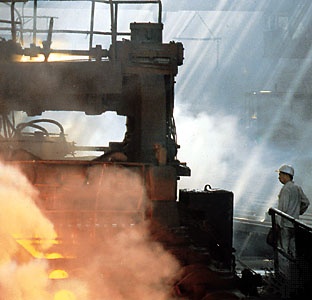Anshan
China
Wade-Giles romanization An-shan
 city, central Liaoning sheng (province), China. It lies about 50 miles (80 km) southwest of Shenyang (Mukden). Originally a post station on the road from northern China to Liaoyang in the Northeast, Anshan was made a town in 1379 and fortified as part of the defenses set up by the Ming dynasty (1368–1644) against the rising power of the Manchus. Under the Qing (Manchu) dynasty (Qing dynasty) (1644–1911/12), however, its walls fell into decay, and during the Boxer Rebellion (an antiforeign uprising in 1900) the town was destroyed by fire. Further destruction followed during the Russo-Japanese War (1904–05), which reduced it to little more than an impoverished village.
city, central Liaoning sheng (province), China. It lies about 50 miles (80 km) southwest of Shenyang (Mukden). Originally a post station on the road from northern China to Liaoyang in the Northeast, Anshan was made a town in 1379 and fortified as part of the defenses set up by the Ming dynasty (1368–1644) against the rising power of the Manchus. Under the Qing (Manchu) dynasty (Qing dynasty) (1644–1911/12), however, its walls fell into decay, and during the Boxer Rebellion (an antiforeign uprising in 1900) the town was destroyed by fire. Further destruction followed during the Russo-Japanese War (1904–05), which reduced it to little more than an impoverished village.Modern Anshan grew up some 6 miles (10 km) north of the old town and was entirely industrial in its origins. In 1909 extensive iron-ore deposits were found in the area, and further iron deposits have been discovered in a belt around Anshan at the towns of Dagushan, Yingtaoyuan, and Gongchangling. The South Manchurian Railway established an ironworks at Anshan in 1918, but production was low until initial difficulties, caused by the low grade of the iron ore, were overcome by new techniques. Under the Japanese occupation of Manchuria (Northeast China) after 1931, Anshan was at first a producer of pig iron for use in the Japanese steel industry, but a local steelworks was established, and production began in 1935. In 1937 Anshan was taken over by the Manchurian Heavy Industry Company, which was partly backed by the Manchukuo (Manzhouguo) government, the Japanese puppet regime in Manchuria. The industry concentrated on the production of steel for armaments, and the city expanded rapidly. In addition to the steelworks, various heavy engineering plants were built, and a shortage of coking coal ended with the development of coal mining at Fuxin and elsewhere.
After World War II Anshan suffered from looting by Soviet forces, who removed most of the advanced equipment. The plant had been heavily bombed toward the end of the war and was further damaged during civil warfare that followed the Soviet withdrawal. By 1948 the population had fallen, and steel production had virtually ceased. After 1949 the rehabilitation of heavy industry at Anshan and elsewhere became a major goal of the communist government. Under the First Five-Year Plan (1953–57) Anshan was built up again into the major iron and steel complex in China and was restocked with the latest equipment, much of it from the Soviet Union. By 1957 it was producing a wide variety of steel products (such as heavy rails, steel plates, seamless tubes, and alloy steels). Anshan also produced equipment for other major iron and steel complexes elsewhere in China. By the late 1950s it was producing more than 40 percent of the total Chinese production of iron and steel. As the chief centre for industrial development, Anshan received numbers of technicians and workers who came from other parts of the country for training. Anshan suffered from the withdrawal of Soviet aid in 1960 and the industrial cutbacks that followed, but the city recovered. By the early 1980s it was producing one-fourth of China's steel.
In the 1960s the attempt to simply increase productive capacity was replaced by efforts to make specialized products, which had previously been imported. In the late 1970s Anshan was China's chief centre for metallurgical research and technological innovation in the steel industry. It was also a centre of the engineering industry. Industrial products include tractors, chemicals, cement, and paper.
Anshan is part of a well-integrated industrial complex in the southern section of Northeast China. It is supplied with coal from Fuxin, Fushun, and Benxi and magnesium from Dashiqiao, and it obtains food largely through Liaoyang. Its steel production is supplied to the engineering and machine-building industry in other large cities in the Northeast. It also has an oil refinery. Anshan is connected by railway with Shenyang and Dalian. Pop. (2002 est.) city, 1,286,513; (2007 est.) urban agglom., 1,639,000.
ancient territory, Iran
also spelled Anzan,
city and territory of ancient Elam, north of modern Shīrāz, southwestern Iran. The city's ruins, covering 350 acres, have yielded major archaeological finds, including examples of early Elamite writing. Anshan came to prominence about 2350 BC as an enemy of the Mesopotamian dynasty of Akkad. Its greatest period, however, was during the 13th and 12th centuries BC, when, as “kings of Anshan and Susa,” Elamite rulers periodically raided Babylonian cities. About 675 the country apparently came to be controlled by Achaemenian Persians, who bore the title “kings of Anshan” down to the accession of Darius I (522 BC).
- Zuni
- Zunyi
- Zunz, Leopold
- Zunzunegui, Juan Antonio de
- Zuozhuan
- Zuo Zongtang
- Zuppke, Bob
- Zurbarán, Francisco de
- zur Hausen, Harald
- Zurita y Castro, Jerónimo de
- Zurvanism
- Zuse computer
- Zutphen
- Zuwārah
- Zvenigorod
- Zveno Group
- Zvishavane
- Zwaardecroon, Hendrick
- Zwangendaba
- Zweig, Arnold
- Zweig, Stefan
- Zwelitsha
- Zwickau
- Zwicky, Fritz
- Zwilich, Ellen Taaffe